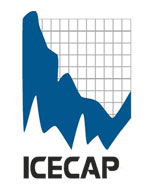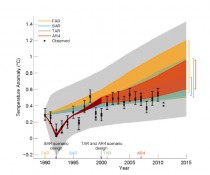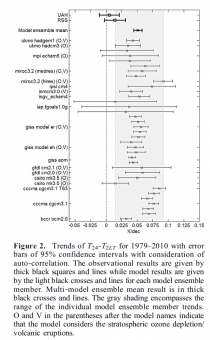Chilling climate-change news
The Washington Times, Tuesday, December 18, 2012
When politicians want evidence to back up their belief that mankind is heating up the planet, they turn to the Intergovernmental Panel on Climate Change (IPCC). The Nobel Prize-winning organization was responsible for the famous hockey-stick graph used to demonstrate the purported warming effect of man-made carbon dioxide. IPCC’s notoriety has turned out to be a two-edged sword, as leaks continue to undermine the group’s core message.
In a statement Friday, IPCC officials confirmed the authenticity of a leaked draft of the forthcoming Fifth Assessment Report on climate. Skeptics seized upon a chart within the document that compares past IPCC predictions with actual temperature readings. The scientific models of 1990’s First Assessment Report forecast temperatures would rise fast, reaching alarming levels by 2010. The mercury refused to cooperate with the warming hypothesis that year. In 2012, temperatures also were frostier than the generous assumptions in each of the group’s four previous reports.
A sensible explanation is that Mother Nature has been playing a more powerful role in determining the weather than some would care to admit. “Natural events created the biggest peaks and dips in the observations portion of the IPCC chart, and the observations run cooler than the models,” meteorologist Anthony Watts told The Washington Times. The biggest recent drop in global temperatures in 1992 was due to the lingering effects of the eruption of Mount Pinatubo in the Philippines. The highest temperature in 1998 coincided with El Nino.
Even though the official charts show no significant warming trend in the past 15 years, the planet may be even cooler than the IPCC figures suggest. Mr. Watts, who runs the Watts Up With That website, points out that IPCC is using adjusted data. In a forthcoming scientific paper, he demonstrates that improper placement of weather stations has resulted in the temperature increase being overstated by 92 percent. The last thing government officials want to hear is that the planet isn’t actually warming.
Reality puts IPCC in a bind. Despite the draft chart’s implicit admission that climate models have exaggerated warming, IPCC has not backed down from the tale that carbon dioxide, a natural byproduct of industrial society, is heating the planet. At the same time, the organization realizes it can no longer hide from the widely known temperature data. Billions of dollars are at stake, and politicians expect IPCC to continue drumming up the fears of imminent cataclysm necessary for advancing their classic tax-and-spend liberal agenda. The spending comes in the form of subsidies to trendy “green” companies (usually run by powerful Democratic donors), and cap-and-trade schemes supply the tax revenue.
David Whitehouse
Because governments control scientific research funding, it’s likely the final version of the IPCC report will find a more creative way to disguise the conflict between theory and reality. It may already be too late. Since the 2009 release of the leaked Climategate emails, the public has been less willing to fall for the claim that mankind can control the weather through public policy. In an ideal world, IPCC scientists would realize the next report is their best chance to come clean.
Whatever one’s view about the leaking of the draft IPCC AR5 report it does make fascinating reading, and given the public scrutiny it is now receiving it will be interesting to see what parts of it are changed when the final report is released in a year or so.
One part of it that should be changed is the section on global surface temperature data and its interpretation.
The analysis of global combined land and ocean surface temperature in AR5 is inadequate for what it admits is seen as the prime statistic of global warming. It is highly selective in the references it quotes and in the use of time periods which obscures important, albeit inconvenient, aspects of the temperature data. It is poorly drafted often making a strong assertion, and then somewhat later qualifying if not contradicting it by admitting its statistical insignificance. This leaves the door open for selective and incomplete quoting.
In Chapter 2 the report says that the AR4 report in 2007 said that the rate of change global temperature in the most recent 50 years is double that of the past 100 years. This is not true and is an example of blatant cherry-picking. Why choose the past 100 and the past 50 years? If you go back to the start of the instrumental era of global temperature measurements, about 1880 (the accuracy of the data is not as good as later years but there is no reason to dismiss it as AR5 does) then of the 0.8 - 0.9 deg C warming seen since then 0.5 deg C of it, i.e. most, occurred prior to 1940 when anthropogenic effects were minimal (according to the IPCC AR4).
AR5 admits that of the warmest years on record the “top ten or so years are statistically indistinguishable from one another.” This is sloppy. The “or so” is significant and should be replaced with a more accurate statement. Despite the admitted statistical indistinguishability of the past ten years (at least) AR5 then goes on to say that 2005 and 2010 “effectively” tied for the warmest years! There is no mention of the contribution to global temperature made by the El Nino in those years!
It is in its treatment of the recent global temperature standstill that AR5 is at its most unevenhanded. It says that much attention has been focused on the “apparent flattening in Hadcrut3 trends,” and it says that “similar length phases of no warming exist in all observational records and in climate model simulations.”
No it hasn’t. The IPCC says that the time when anthropogenic influence dominated began between 1960-80. AR5 takes 1979 - 2011 as a period for analysis when temperatures started rising after a 40-year standstill. The fact that is obvious from the data is that the past 16 years of no global temperature increase is unusual and is not an “apparent flattening.” It is a total flattening for 16 years (as AR5 confusingly admits later on), just over half of the duration of the recent warming spell. Flat periods have existed before but they were in the era when mankind’s influence was not significant. The 16-year flatness since mankind has been the prime climatic influence has been the cause of much discussion in the peer-reviewed literature, something that this AR5 does not reflect.
AR5 goes on to say that with the introduction of Hadcrut4 (and its inclusion of high latitude northern hemisphere data) there is now a warming trend. No it isn’t. Look at the Hadcrut4 data and, as the GWPF has demonstrated, it is warmer than Hadcrut3, but it is also flatter for the past 15 years. AR5 also adds that “all products show a warming trend since 1998.” That this is not the case seems to be something that AR5 concedes a little later in the report when it that none of the warming trends they quote are statistically significant!
Referenced And Dismissed
Consider AR5’s summary: “It is virtually certain that global near surface temperatures have increased. Globally averaged near-surface combined land and ocean temperatures, according to several independent analyses, are consistent in exhibiting warming since 1901, much of which has occurred since 1979.”
Nobody doubts that the world has warmed since 1901. But why choose 1901, and what warming is natural and what is anthropogenic? As we have seen the last comment is wrong.
AR5 says: “Super-imposed upon the long-term changes are short-term climatic variations, so warming is not monotonic and trend estimates at decadal or shorter timescales tend to be dominated by short-term variations.”
So since 1979 we have has about 16 years of warming and 16 years of temperature standstill. Which is the short-term natural variation? The warming or the standstill?
AR5 says: “A rise in global average surface temperatures is the best-known indicator of climate change. Although each year and even decade is not always warmer than the last, global surface temperatures have warmed substantially since 1900.” Nobody, of whatever “skeptical” persuasion would disagree with that.
I can’t help but conclude that the pages of the GWPF contain a better analysis than is present in AR5, which is a mess written from a point of view that wants to reference the recent standstill in global temperatures but not impartially consider its implications.
The unacknowledged (in AR5) problem of the global temperature standstill of the past 16 years is well shown in its fig 1.4, which is seen at the head of this article. Click on the image to enlarge. It shows the actual global temperature vs projections made by previous IPCC reports. It is obvious that none of the IPCC projections were any good. The inclusion of the 2012 data, which I hope will be in the 2013 report, will make the comparison between real and predicted effects appear ever starker.
In summary, the global temperature of the past 16 years is a real effect that in any realistic and thorough analysis of the scientific literature is seen to be a significant problem for climate science, indeed it may currently be the biggest problem in climate science. To have it swept under the carpet with a selective use of data and reference material supported by cherry-picked data and timescales is not going to advance its understanding, and is also a disservice to science.
Climate alarmists didn’t get all they wanted but they put us on a very slippery slope
David Rothbard and Craig Rucker
The eighteenth Conference of Parties to the Kyoto Protocol (COP-18) has ended. It was the latest chapter in the interminable negotiations over wealth redistribution and control of energy use and economic growth - in the name of preventing “dangerous manmade global warming.”
For people who believe humans can prevent “catastrophic climate change” by adjusting atmospheric carbon dioxide levels by a few parts per million - or are determined to crave control “destructive” fossil fuels and “unsustainable” economic systems - Doha was a failure.
Only 37 of 194 nations signed the treaty that replaces the Kyoto Protocol, which expires December 31 - and several countries may withdraw their consent. That means the new agreement is legally non-binding and covers only 15% of global carbon dioxide emissions.
While the European Union joined in and remains committed to “carbon trading” (making former UNFCC chair Yvo DeBoer happy in his new role as a carbon trader, á la Al Gore), the United States, Brazil, Russia, India, China, Canada, Japan and other major emitters refused to sign, and the new treaty sets no binding emission limits. Atmospheric CO2 levels will thus continue to climb - and climate campaigners will remain distraught over allegedly disastrous weather events, imminent habitat devastation, species extinctions, injustice for the world’s poor, and the disappearance of island nations beneath the waves.
For those who say computer models are meaningless, climate change and weather extremes are natural, and economic growth should be sustained to lift more billions out of poverty, Doha represents a partial success. Few nations signed the treaty, even the Obama Administration did not commit to it, the document is not binding, and countless billions of dollars will be available for continued economic development and disaster relief. instead of being squandered on fruitless attempts to control Earth’s infinitely complex climate and weather.
Even Christina Figueres, DeBoer’s successor at the UN Framework Convention on Climate Change, could proclaim victory. She wants to keep the planet’s temperature from rising more than the internationally agreed maximum of two degrees Celsius. That goal has arguably been reached already. There has been no detectable increase in average global temperatures for 16 years.
In fact, while last summer was hot and dry in much of the continental USA, nearing records set during the Dust Bowl years of the 1930s, it was a very cold summer in Alaska and parts of Europe. Winter 2012 was snowy and nasty in Central Europe and very cold in South Africa and South America. Britain just had its coldest autumn in nineteen years, Himalayan glaciers are growing, interior Greenland is not melting, summer Antarctic sea ice is near record extent, and seas are not rising any faster.
All this helps explain why climate alarmists keep changing their rhetoric: from global cooling to global warming, to climate change to climate disruption, and now to extreme weather. Indeed, they now try to link every unusual weather event to CO2 (and now methane, or natural gas, the fuel produced through hydraulic fracturing or fracking). However, as Dr. Roger Pielke, Jr. has noted, when the Atlantic hurricane season starts next June 1, it will have been 2,777 days since a category 3, 4 or 5 hurricane made landfall along the U.S. coast, the longest such period since 1900. 2012 also marked the quietest U.S. tornado season on record; only twelve tornadoes touched down in the United States in July 2012.
Of course, there are always disasters and human tragedies at the hands of a not-always-benevolent Mother Nature. Hardly a year has ever gone by without many such weather events somewhere on Planet Earth.
This year, however, climate alarmists have blamed virtually all of them on humans and CO2 emissions from Sandy in the USA to 2011 and 2012 typhoons in the Philippines, and droughts in Africa. It’s easy to see why. As a Greenpeace director cogently explained, “The key issue is money” as in the redistribution of wealth from rich, formerly rich and soon-to-be formerly rich nations to still poor countries. The other issue is power and control: as in who gets to make energy, economic, and human health and welfare decisions: individuals, families, communities and nations – or eco-activists and UN bureaucrats.
That brings us to the in-between: the uncharted waters separating “bitter failure” and “partial success.”
As climate activists and media “journalists” have observed, there is no legally binding agreement on reducing greenhouse gas emissions. The world’s two biggest CO2 emitters, China and the United States, did not sign. What was agreed to contains only vague promises that, “beginning in 2020, at least $100 billion a year will flow from public, private and other sources” to poor countries, supposedly to help them cope with the “devastating effects” of climate change and “extreme weather.” There is no agreement as to where that $1 trillion per decade will come from, or how much will be available annually between now and 2020, especially if the global economic downturn continues.
But don’t believe the vague promises, bitter failure, bitterly disappointed rhetoric. The climate alarmists got a lot of what they came for, they gave up little or nothing, they’ll be back for more, and in the meantime they will still get billions of dollars annually from taxpayers – to conduct climate change causation, mitigation, adaptation and compensation “research,” issue “balanced reports,” and attend many more conferences (all expenses paid) where virtually no one except alarmists is allowed to speak or participate in official “discussions” and “negotiations.”
More than 7,000 environmental NGO activists attended the Doha confab and next time around they won’t forget who sent them, now that Jonathan Pershing, chief U.S. negotiator for climate change at Doha, has pointedly reminded them who paid for their presence in Qatar. They and the official delegates will be there for specific objectives: more money, more power, more control.
In Doha, they reached several benchmarks that they had achieved during previous COP events. Most important, they enshrined in the treaty the concept ‘of loss and damage” supposedly resulting from “manmade climate change” and secured pledges from “rich” nations that poor countries would receive billions of dollars per year in “all” to repair any “loss and damage,” as part of a “climate compensation mechanism.” They also incorporated “principles” of “equity” and “justice” and “common but differentiated responsibilities” to distinguish between nations that “caused” climate change and “extreme weather events” and countries that presumably did not or are “especially vulnerable.”
It is true that words like “compensation,” “fault” and “liability” were excised from the final treaty language and that it will be all but impossible to determine how much, if any, loss and damage from a tornado, hurricane, typhoon, flood or drought was due to “manmade climate change” versus how much from natural climate change and natural, normal extreme weather events. Who will pay how much, from existing aid programs versus new programs, and through what UN or other conduits, will likewise have to be decided at one of the presumably many future Conferences Of Parties to the new climate agreement.
“This is just the beginning of the process,” a Greenpeace activist, helpfully explained.
Indeed, the “parties” and thus their taxpayers, food and energy consumers, and citizens hoping to pursue their dreams are slowly but surely, piece by piece, surrendering their rights, freedoms, sovereignty and hard-earned wealth to a gaggle of unelected and unaccountable activists, agitators, bureaucrats, autocrats and kleptocrats. The slippery slope is just ahead, if we are not already on it.
The scientific case for manmade global warming disasters grows weaker by the day. But no one should ever underestimate the desperation, audacity and political brilliance of those who have staked their careers, reputations, salaries and pensions on the notion that our energy use and quest for improved living standards for all humanity have somehow usurped the natural forces that have driven climate changes from time immemorial. We underestimate the alarmists at our peril.
David Rothbard serves as president of the Washington, DC-based Committee For A Constructive Tomorrow (www.CFACT.org and www.CFACT.tv). Craig Rucker is CFACT’s executive director.
Posted by Jeff Condon on September 11, 2011
It looks like the “skeptics” (if that’s what you call them) were right again. Steve McIntyre pointed out a paper in print at GRL that was similar in content to some of his an Ross McKitrick’s own work (MMH10) demonstrating again that climate models run generally higher than observations. This is particularly true in the case of the tropical warming in the upper troposphere covered in this paper - On the warming in the tropical upper troposphere:Models versus observations (free). The paper was written by Qiang Fu, Syukuro Manabe, and Celeste M. Johanson (FMJ11).
Abstract:
[1] IPCC (Intergovernmental Panel on Climate Change) AR4 (Fourth Assessment Report) GCMs (General Circulation Models) predict a tropical tropospheric warming that increases with height, reaches its maximum at ∼200 hPa, and decreases to zero near the tropical tropopause. This study examines the GCM‐predicted maximum warming in the tropical upper troposphere using satellite MSU (microwave sounding unit)‐derived deeplayer temperatures in the tropical upper‐ and lower‐middle troposphere for 1979 to 2010. While satellite MSU/AMSU observations generally support GCM results with tropical deep‐layer tropospheric warming faster than surface, it is evident that the AR4 GCMs exaggerate the increase in static stability between tropical middle and upper troposphere during the last three decades. Citation: Fu, Q., S. Manabe, and C. M. Johanson (2011), On the warming in the tropical upper troposphere:
My bold of course. This is a key factor in the global warming debate as the missing hot spot is an indicator that feedback mechanisms are not properly quantified in climate models. The results of FMJ11 are rather stunning to see in print these days as there was um… considerable review difficulty experienced in rebutting the Santer 08 paper claiming that models do match observations. It is worth noting that Santer has a new paper out on the topic which I will discuss in another post here.
Now this is a slightly different claim than Santer and MMH10 which looked at simple trends of the atmosphere, but the result is perhaps more important in that climate science is now recognizing in print that key differences between observed vs modeled feedbacks DO exist and that modeled trends are overstated. I have yet to see any of the best known climate scientists admit these unquestionable discrepancies. The methods of the paper seem reasonable enough and are not difficult to follow except that you do need to understand the data in question is the difference in the temperature trends between tropical upper‐ and lower‐middle troposphere (T24‐T2LT) as defined and discussed in the paper linked above. How much upper vs lower troposphere warming is observed is a result of CO2 heat capture and feedback in real world and modeled climate systems.
Below is the key plot of modeled vs observed temperatures:
As we have seen so often in blogs and print, the models run hot in comparison to observed trends both individually and in aggregate. Again, the difference here is that this paper analyzes the heat buildup region of the tropical troposphere which is a key prediction of climate models. This is different from the result of MMH10 which shows that the model trends are generally high. Instead, this is a clue to the reason as to WHY they are running high.
In the text, however, a simple statement is made which corroborates MMH10, the numerous posts by Chad Herman at TreesFortheForest and Steve McIntyre on Briffa 08, Lucia and others and contradicts the general conclusions of Santer08 that climate models are accurately representing observation.
Tropical surface temperature trend from multi‐model ensemble mean is more than 60% larger than those from observations (Table 1), indicating that AR4 GCMs overestimate the warming in the tropics for 1979 to 2010. Thus larger T24‐T2LT trends from AR4 GCMs are partly caused by GCM overestimation of tropical temperature trends.
The models are running too hot. Either that or the thermometers need to be replaced. There has been a lot of denial in the climate scientist community on these basic facts perhaps we should begin collecting quotes for the future retractions as the main stream will soon need to address this reality. One can’t help but wonder if a change in predicted warming magnitude will affect the overall anti-industrial, anti-capitalist message of the climate community.
The conclusion with my bold:
One of the striking features in GCM‐predicted climate change due to the increase of greenhouse gases is the much enhanced warming in the tropical upper troposphere. Here we examine this feature by using satellite MSU/AMSUderived deep‐layer temperatures in the tropical upper‐ (T24) and lower‐ (T2LT) middle troposphere for 1979to2010. It is shown that T24‐T2LT trends from both RSS and UAH are significantly smaller than those from AR4 GCMs. This indicates possible common errors among GCMs although we cannot exclude the possibility that the discrepancy between models and observations is partly caused by biases in satellite data.
IPCC AR4 GCMs overestimate the warming in the tropics for 1979 to 2010, which is partly responsible for the larger T24‐T2LT trends in GCMs. It is found that the discrepancy between model and observations is also caused by the trend ratio of T24 to T2LT, which is ∼1.2 from models but ∼1.1 from observations. While strong observational evidence indicates that tropical deep‐layer troposphere warms faster than surface, this study suggests that the AR4 GCMs may exaggerate the increase in static stability between tropical middle and upper troposphere in the last three decades. In view of the importance of the enhanced tropical upper tropospheric warming to the climate sensitivity and to the change of atmospheric circulations, it is critically important to understand the causes responsible for the discrepancy between the models and observations.
With so many papers coming out in support of a less severe warming effect, the climate community might do well to accelerate the release of AR5 before they are forced to recognize these problems. As an aside, it isn’t the message that is causing public opinion to change, it isn’t the fact that the public doesn’t understand, it is the regular discovery of the truly uncertain nature of the climate future which cuts into the message.
-----------
This is supported by the Hadley Balloon and NOAA buoy based ocean temperatures.
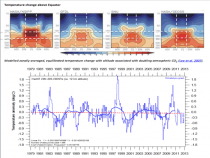
Enlarged. Top row shows mode forecast warming concentrated in polar low levels in tropical high levels. Bottom show the Hadley weather balloon for the level supposedly at the core of the warming.
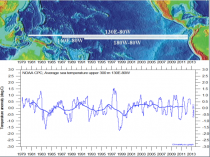
Enlarged This is the 0 to 300m temperature trend for the entire tropical Pacific. CO2 is supposed to be warming the oceans in the tropics and translating to the warming above. Both are not observed.
